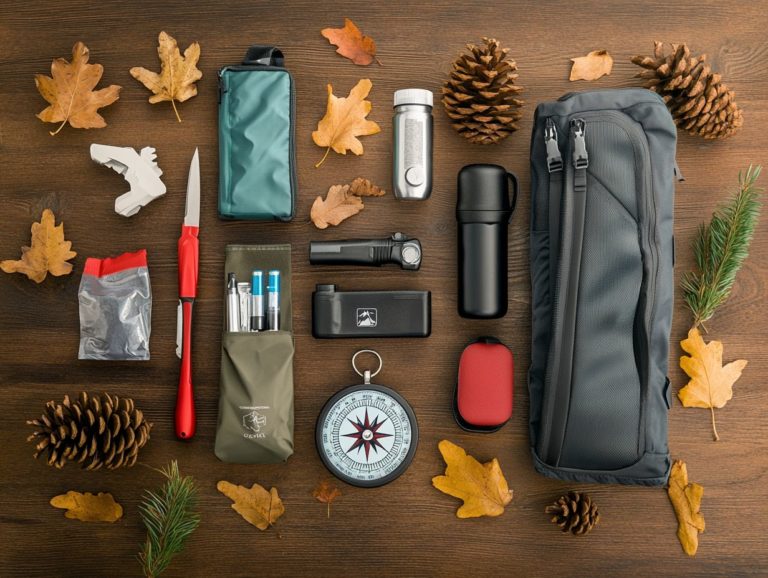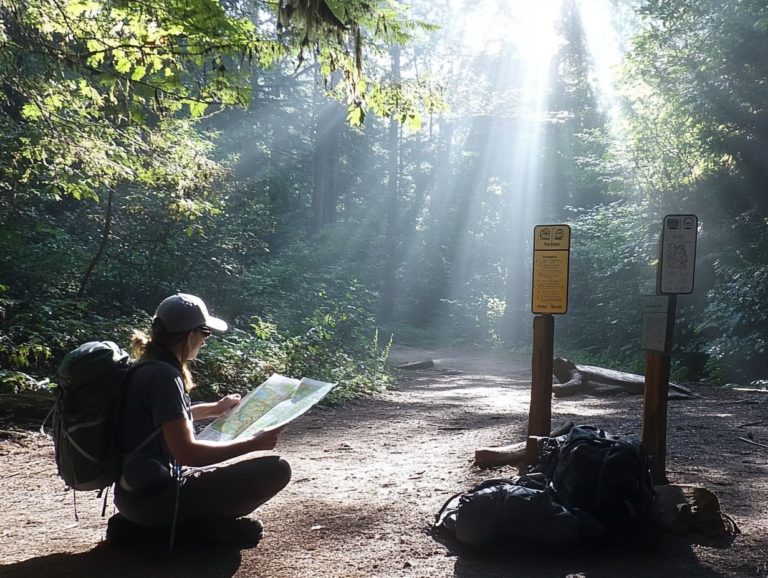The Importance of Stretching Before Hiking
Hiking can be an exhilarating way to connect with nature, but preparing your body is essential for a safe and enjoyable experience. Stretching before you hit the trails is a game changer for your hiking adventures!
This article explores various types of stretches specifically tailored for hiking, guiding you on how to seamlessly incorporate them into your routine. It also highlights other vital pre-hiking preparations, such as hydration and selecting the right gear.
Ready to elevate your hiking experience? Let’s dive in!
Contents
- Key Takeaways:
- The Benefits of Stretching Before Hiking
- Types of Stretches for Hiking
- How to Incorporate Stretching into Your Hiking Routine
- Other Pre-Hiking Preparations
- Frequently Asked Questions
- Why is stretching important before hiking?
- What are the benefits of stretching before hiking?
- How long should I stretch before hiking?
- Which stretches are most important before hiking? The best stretches to include in your routine can greatly improve mobility and promote effective movement.
- Can stretching prevent injuries while hiking? Safe stretching techniques can significantly reduce the likelihood of injury.
- Is stretching only important before long hikes? Know your limit and understand that stretching is crucial for any hike, including hiking or backpacking adventures.
Key Takeaways:

- Stretching before hiking can improve flexibility and range of motion, making your hike more enjoyable and less strenuous.
- Incorporating dynamic stretches, specific to hiking muscles, can reduce the risk of injuries on the trail.
- Proper hydration, nutrition, and gear are also important for a successful hike, but don t forget to make stretching a regular part of your pre-hiking preparations.
The Benefits of Stretching Before Hiking
Stretching before you embark on a hike is more than just a ritual; it s an essential component that elevates your outdoor adventure by priming your body for the physical challenges ahead. A well-structured stretching routine can greatly enhance your flexibility, granting you a wider range of motion crucial for tackling those rough trails.
It significantly reduces the risk of injury, allowing you to stay active and pain-free throughout your journey. Whether you’re traversing the majestic Atlas Mountains or exploring the scenic trails of Virginia, recognizing the importance of stretching can dramatically enhance your performance and overall enjoyment on the trail.
Improved Flexibility and Range of Motion
Improved flexibility and range of motion are essential elements of stretching that can profoundly elevate your outdoor experience while hiking. By incorporating targeted stretches into your regular routine, you can significantly reduce the risk of injury and enhance your ability to navigate rough trails with confidence.
For instance, the hip flexor stretch is crucial in improving the flexibility of your hip muscles, which often gets a workout during those steep ascents. Likewise, the hamstring stretch not only lengthens the muscles at the back of your thigh but also supports balance and stability on uneven ground.
These stretches do more than just promote better mobility; they directly enhance your overall hiking performance. This means you can explore longer distances with greater ease and comfort, making every hike an enjoyable adventure.
Reduced Risk of Injury
A well-structured stretching routine can be your best ally in reducing the risk of injury during hikes. It helps address pesky concerns like pain and soreness. Research indicates that proper stretching can cut injuries by up to 30% for outdoor enthusiasts like yourself.
As a hiker, you re particularly vulnerable to various injuries, such as sprained ankles and knee strains, which can quickly derail your adventures. Incorporating specific stretches like calf and hamstring stretches enhances flexibility and strength in key areas.
A simple ankle rotation can prepare your joints for those uneven terrains, while quadriceps stretches will support knee stability. By prioritizing these exercises, you can savor longer, safer hikes without the looming fear of injury.
Types of Stretches for Hiking
For hikers, two essential types of stretches stand out: dynamic stretches, which you should perform before hitting the trail to warm up your muscles, and static stretches, designed for optimal recovery after your hike. Remember, integrating these stretches into your routine will make a significant difference in your hiking experience.
Start your stretching routine today and feel the difference on your next hike!
Dynamic vs. Static Stretches
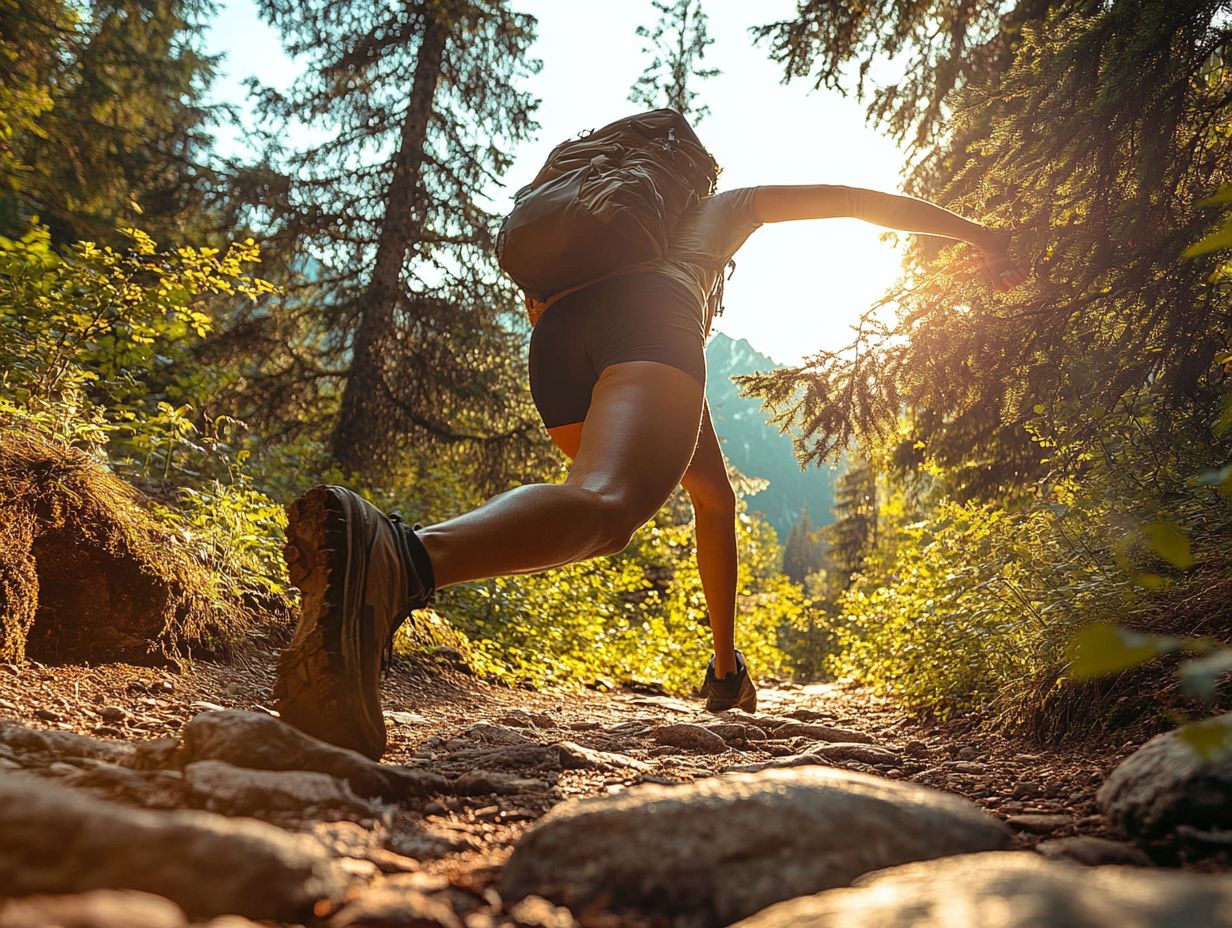
Dynamic stretches are your best bet for warming up before hitting the trails. Static stretches play a crucial role in cooling down after your hike.
These two types of stretches serve unique purposes that can significantly elevate your performance and aid in recovery.
- Dynamic stretches think leg swings, walking lunges, and arm circles help boost blood flow and flexibility in your muscles, priming your body for the challenges that lie ahead.
- Static stretches, such as the seated forward bend or standing quad stretch, are perfect for your post-hike routine. They promote muscle relaxation and gradually improve your flexibility over time.
By incorporating both dynamic and static stretches into your hiking regimen, you not only reduce the risk of injury but also enhance your overall mobility. This makes those challenging terrains feel a bit more manageable.
Specific Stretches for Hiking Muscles
To elevate your hiking performance, it’s essential to incorporate specific stretches that target key muscle groups such as the hamstrings (the muscles at the back of your thighs), hip flexors, and shoulders.
By honing in on these areas, you can enhance flexibility, prevent injuries, and boost your overall endurance on the trails.
Consider the standing quadriceps stretch, which effectively targets the front thigh muscles. This helps you maintain balance and power during those challenging climbs.
The seated forward bend stretch is another gem, elongating your hamstrings crucial for conquering uphill treks.
Don t underestimate the runner s lunge; this stretch opens up your hip flexors and enhances mobility, ensuring you’re ready for any adventure.
Let s not forget the gentle shoulder stretch, which is invaluable for easing the tension that builds up from carrying a backpack. This makes your hiking experience not just enjoyable, but also pain-free.
How to Incorporate Stretching into Your Hiking Routine
Incorporating stretching into your hiking routine demands a thoughtful strategy. Emphasizing the timing and frequency of your stretches unlocks optimal benefits.
When and How Often to Stretch
Knowing when and how often to stretch is essential for maximizing the benefits of your pre and post-hike routines.
To truly enhance your overall performance and minimize the risk of injury, incorporate stretching at specific intervals especially before you set off on a hike and after you ve completed one.
Aim to engage in a series of movements to warm up your muscles about 10 to 15 minutes prior to your hike. Focus on key muscle groups like your hamstrings, calves, and shoulders.
After your hike, give static stretches the attention they deserve. Holding each stretch for 15 to 30 seconds can promote flexibility and aid in recovery.
By regularly integrating these stretching practices into your hiking schedule, you can significantly boost your endurance and keep yourself feeling refreshed and ready for your next adventure.
Tips for Proper Form and Technique
Maintaining proper form and technique during stretching is essential for ensuring safe practices that help you avoid injury.
Focus on keeping your body aligned to maximize your stretching. It s crucial to concentrate on alignment and body mechanics to fully reap the benefits of your stretching routine.
Common missteps, like overstretching or holding positions incorrectly, can lead to unnecessary strain or discomfort. For example, when stretching your hamstrings, bending your back instead of keeping it straight can significantly reduce the effectiveness of the stretch.
Neglecting to breathe deeply can create tension that hinders your progress.
By paying close attention to your body posture and breathing, you can enhance your flexibility, promote relaxation, and maximize the results of each stretch. Ultimately, this mindful approach makes your routine not only safer but also far more effective.
Other Pre-Hiking Preparations
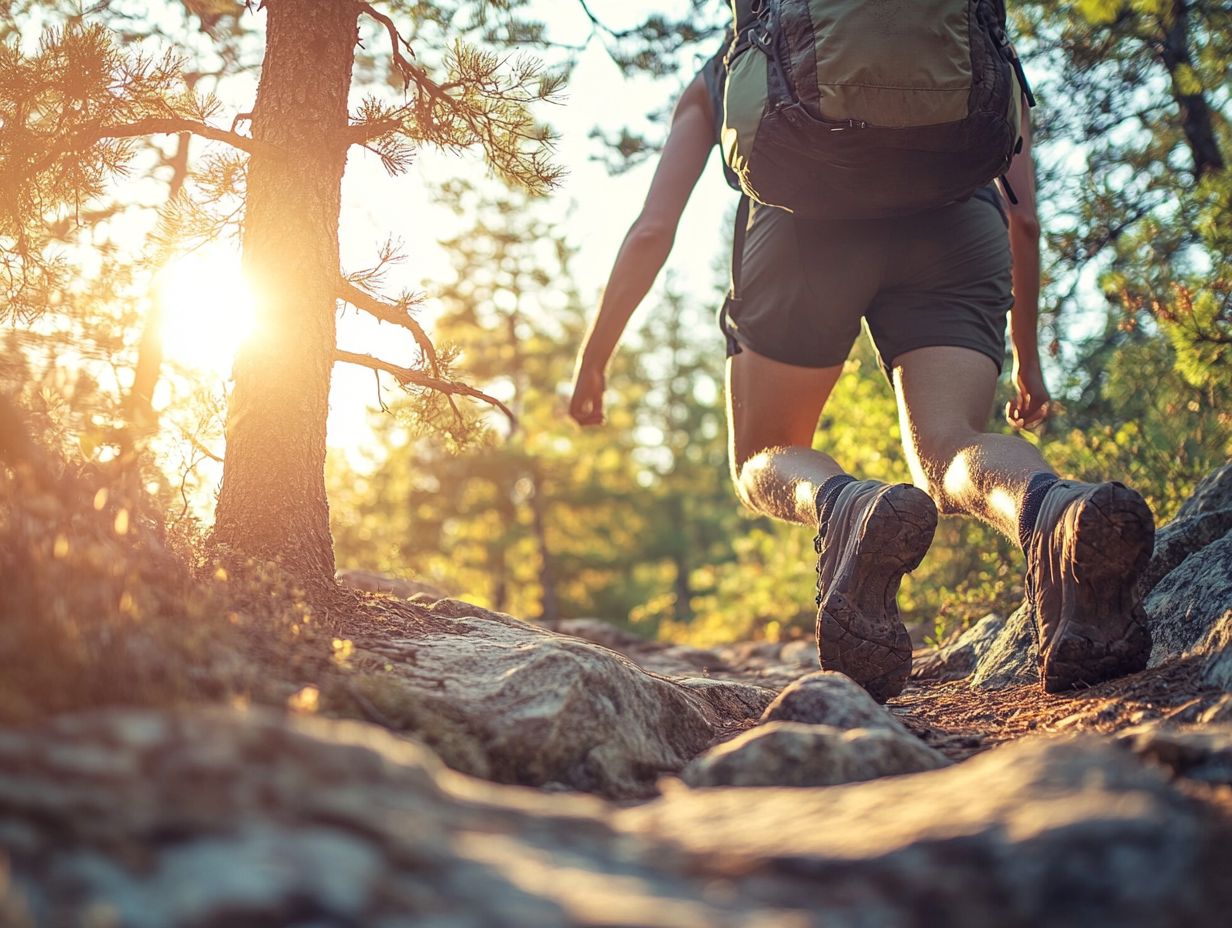
Along with incorporating stretching into your routine, ensuring proper hydration and nutrition is essential for your pre-hiking preparations.
Selecting suitable gear and footwear also plays a critical role in setting the stage for a successful outdoor adventure.
Hydration and Nutrition
Hydration and proper nutrition are essential for maintaining your energy levels during physical activities like hiking.
To ensure your trekking experience is successful, prioritize staying hydrated before you hit the trail. Make it a point to replenish fluids throughout your journey. Aim to drink water regularly, targeting about half a liter per hour, especially when the weather heats up or during those challenging climbs.
Along with staying hydrated, eat a balanced mix of carbohydrates, proteins, and healthy fats before you set off to give you the energy you need. Consider packing foods such as:
- Nuts
- Dried fruits
- Whole-grain snacks
These options are excellent choices. Don’t miss out on these vital tools for your hike! Also, don’t overlook the value of energy gels or electrolyte drinks; they can provide that extra boost you need during breaks on your hike.
Proper Gear and Footwear
Having the right gear and footwear is essential for ensuring your safety and comfort during hiking adventures. Choosing the appropriate hiking boots can dramatically impact your experience, as they provide the necessary support and traction on various terrains.
Breathe easy with clothing layers that help regulate your body temperature and moisture, making every trek more enjoyable. Additionally, make sure you pack essential safety items like first aid kits and navigation tools. They ll keep you confident and ready for anything on the trail!
You should also invest in a reliable backpack equipped with hydration systems (a built-in water reservoir); this allows for easy access to water while ensuring proper weight distribution. A thoughtfully selected collection of gear elevates your outdoor experience, transforming a simple hike into a memorable adventure.
Frequently Asked Questions
Why is stretching important before hiking?
Stretching before hiking helps warm up your muscles and prepares them for physical activity. It also increases your flexibility and reduces the risk of injury.
What are the benefits of stretching before hiking?
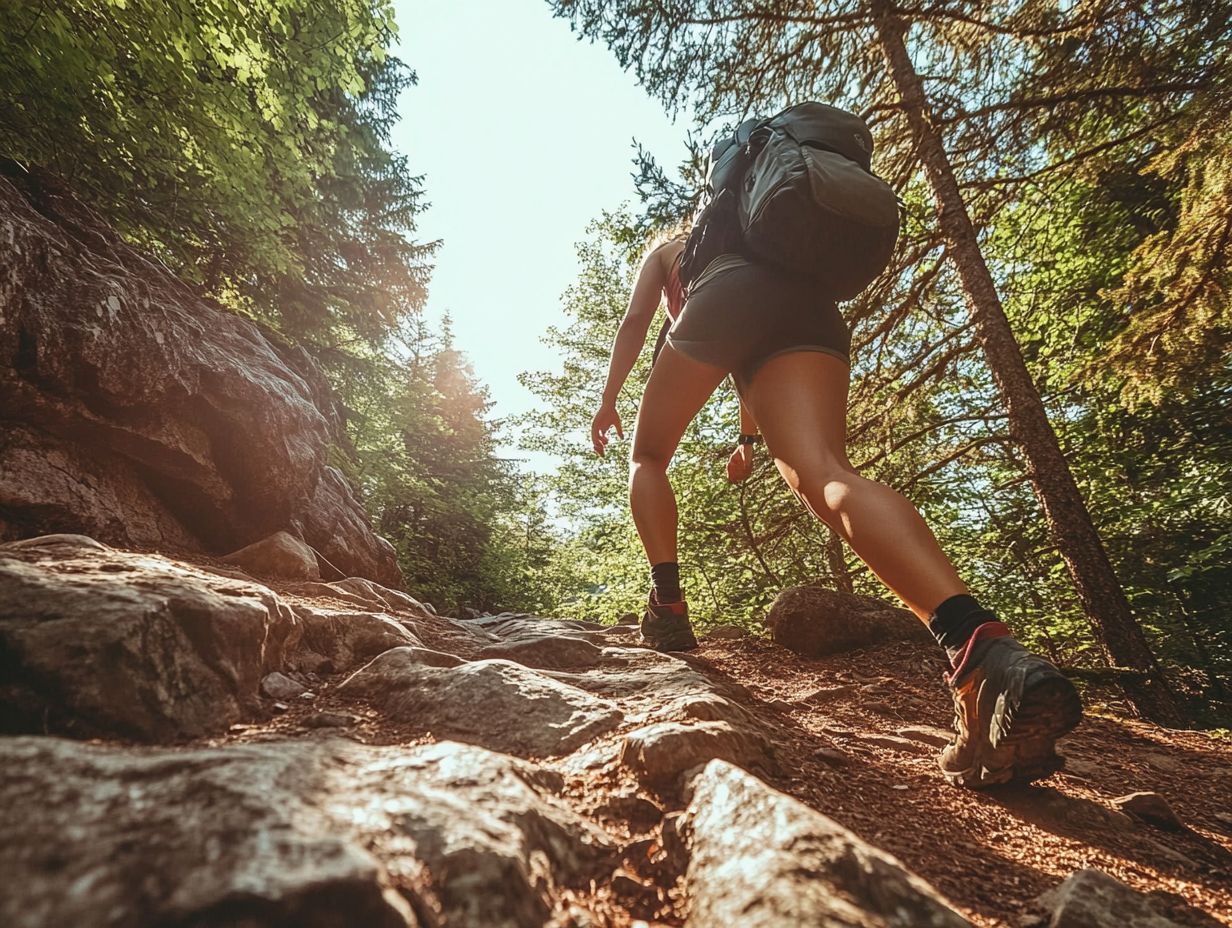
Stretching before hiking can improve your range of motion, increase blood flow and oxygen to your muscles, and enhance your overall performance on the trail.
How long should I stretch before hiking?
It’s recommended to spend at least 10-15 minutes stretching before hiking. This will give your muscles enough time to warm up and become more flexible.
Which stretches are most important before hiking? The best stretches to include in your routine can greatly improve mobility and promote effective movement.
The most important stretches before hiking are ones that target your legs, hips, and core muscles. Some examples include lunges, calf stretches, and torso rotations.
Can stretching prevent injuries while hiking? Safe stretching techniques can significantly reduce the likelihood of injury.
Yes, stretching before hiking can help prevent injuries such as muscle strains, cramps, and sprains. It also reduces muscle soreness and stiffness after the hike.
Is stretching only important before long hikes? Know your limit and understand that stretching is crucial for any hike, including hiking or backpacking adventures.
No, stretching is important before any hike, regardless of the length. Even short hikes can put strain on your muscles, so it’s crucial to warm them up beforehand.


